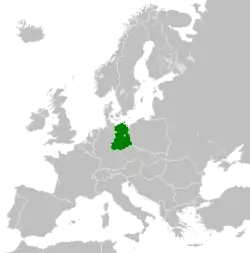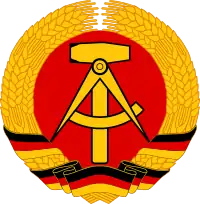East Germany–Yugoslavia relations
East Germany–Yugoslavia relations are historical foreign and bilateral relations between German Democratic Republic and Socialist Federal Republic of Yugoslavia, both of which are now former states. Yugoslavia recognized East Germany on 15 October 1957.[1] Decision to recognize East Germany pushed West Germany to apply the Hallstein Doctrine for the first time in history, limiting relations almost exclusively to the economics field for eleven years (until 1968) until the initiation of the Ostpolitik.[2][3] At the time, Yugoslav citizens were one of the largest groups of Gastarbeiters. Significantly smaller Yugoslav community lived in East Berlin, mostly as diplomatic and economic cooperation representatives.[4] Yugoslavia recognized East Germany as a part of its efforts to improve relations with the Soviet Union after the 1948 Tito–Stalin split. At the time 1955 Belgrade declaration was signed and Yugoslavia verbally supported 1956 Soviet Intervention in Hungary. This support was diametrically opposite to future Belgrade's strong opposition to the 1968 Warsaw Pact invasion of Czechoslovakia which led to second rapprochement between Yugoslavia and the Western Bloc.
East Germany |
Yugoslavia |
|---|---|



During the September 1964 official visit to the People's Republic of Bulgaria (conducted by train) Walter Ulbricht, the Chairman of the East German State Council, unofficially visited Belgrade where he met Yugoslav President Josip Broz Tito.[3] Contrary to countries of the Eastern Bloc, Yugoslav State Security Administration never developed substantial cooperation with East German Stasi due to continual ideological and political antagonism between Belgrade and East Berlin.[4]
See also
Further reading
- Nećak, Dušan (2002). Hallsteinova doktrina in Jugoslavija. Tito med Zvezno republiko Nemčijo in Nemško demokratično republiko. Ljubljana: Razprave ZIFF. (Croatian translation published by Srednja Europa, 2004)
References
- Akrap, Gordan (2011). "Suradnja izvještajno-sigurnosnih sustava DDR-a i SFRJ". National security and the future. 12 (1–2): 11–33.
- Kosanović, Milan (2009). "Brandt and Tito: Between Ostpolitik and Nonalignment". In Fink, Carole; Schaefer, Bernd (eds.). Ostpolitik, 1969-1974: European and Global Responses. New York: German Historical Institute Washington DC & Cambridge University Press. pp. 232–243. ISBN 978-0-521-89970-3.
- Maricic, Alan (2019). “Lucky that East Germany also exists”: Yugoslavia between the Federal Republic of Germany and the German Democratic Republic (1955-1968) (Doctor of Philosophy). University of Waterloo. Retrieved 11 August 2020.
- "Kako su "jugovići" s istočne strane Berlinskog zida doživjeli njegov pad". Deutsche Welle. Retrieved 11 August 2020.

